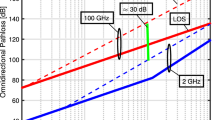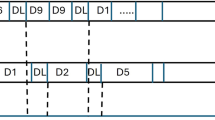Abstract
In a cooperative network, the adverse effect of fading is tackled with the assist of intermediate node using spatial diversity. The system model consists of an origin node (O), an intermediate node (I) and a final node (F). In this paper, we derive an end to end symbol error probability (SEP) for the proposed novel max-min switched diversity scheme over a correlated Nakagami-m fading channels. The modulation scheme used in the system model is M-ary Phase Shift Keying (MPSK). The intermediate node utilizes decode and forward (DF) protocol for retransmission. In this system, we assumed that there is a correlation exists between originating-to-intermediate node link and intermediate-to-final node link. The proposed scheme utilizes full channel state information (CSI) therefore offers better performance. The result shows that the proposed scheme performs better than the other competing schemes. It is also found that the correlated channels reduce the end-to-end system performance than the uncorrelated scenario.






Similar content being viewed by others
References
Nosratinia, A., Hunter, T. E., & Hedayat, A. (2004). Cooperative communication in wireless networks. IEEE Communications Magazine, 42(10), 74–80.
Rappaport, T. S. (1996). Wireless communications: Principles and practice (Vol. 2). New Jersey: Prentice Hall PTR.
Yang, L., & Yang, H-C. (2005). Cooperator switch diversity in cooperative networks. In 2005 IEEE Pacific rim conference on communications, computers and signal processing, 2005. PACRIM, pp. 308–311, IEEE.
Mller, A., & Speidel, J. (2010). Switch-and-stay transmit diversity for cooperative decode-and-forward systems. In Wireless communications and networking conference (WCNC), pp. 1–6.
Selvaraj, M. D., & Mallik, R. K. (2009). Error analysis of the decode and forward protocol with selection combining. IEEE Transactions on Wireless Communications, 8(6), 3086–3094.
Selvaraj, M. D., & Mallik, R. K. (2012). Performance of full CSI selection combining for cooperative diversity systems’. IEEE Transactions on Communications, 60(9), 2482–2488.
Ko, Y.-C., Alouini, M.-S., & Simon, M. K. (2000). Average SNR of dual selection combining over correlated Nakagami-m fading channels. IEEE Communications Letters, 4(1), 12–14.
Li, G., et al. (2012). Performance analysis of incremental relaying for amplify-and-forward cooperative networks in Nakagami-m channels. In 2012 2nd international conference on computer science and network technology (ICCSNT), IEEE, pp. 1681–1685.
Kim, Y., & Beaulieu, N. (2015). SEP of decode-and-forward cooperative systems with relay selection in Nakagami-\(m\) fading channels. IEEE Transactions on Vechicular Technology, 64(5), 1882–1883.
Swaminathan, R., Roy, R., & Selvaraj, M. (2015). Performance comparison of selection combining with full CSI and switch-and-examine combining with and without post-selection. IEEE Transactions on Vehicular Technology, 65(5), 3217–3230.
Yang, K., et al. (2013). Performance analysis of cooperative DF relaying over correlated Nakagami-m fading channels. In 2013 IEEE international conference on communications (ICC), IEEE.
Selvaraj, M. D., & Roy, R. (2013). Performance analysis of double correlated selection combining for cooperative diversity systems. In 2013 national conference on communications (NCC), IEEE, pp. 1–5.
Lingwei, X., Zhang, H., & Gulliver, A. (2016). Performance analysis of switched diversity combining system. Intenational Journal of Signal Processing, Image Processing and Pattern Recognition, 9(2), 421–432.
Femenias, G., & Furio, I. (1997). Analysis of switched diversity TCM-MPSK systems on Nakagami fading channels. IEEE Transactions on Vehicular Technology, 46(1), 102–107.
Mesleh, R., Ikki, S. S., & Aggoune, H. M. (2015). Quadrature spatial modulation. IEEE Transactions on Vehicular Technology, 64(6), 2738–2742.
Craig, J. W. (1991). A new simple and exact result for calculating the probability of error for two-dimensional signal constellations. In The proceedings of IEEE MILCOM, pp. 571–575.
Proakis, J. (2001). Digital communications. new york, ny: McGraw-Hill.
Gradshteyn, I. S., & Ryzhik, I. M. (2000). Table of integrals, series, and products. Translated from the Russian. Translation edited and with a preface by Alan Jeffrey and Daniel Zwillinger.
Author information
Authors and Affiliations
Corresponding author
Rights and permissions
About this article
Cite this article
Annadurai, C., Nagarajan, V. Performance Analysis for Cooperative Ad-hoc Networks in the Presence of Correlated Nakagami Fading. Wireless Pers Commun 92, 1443–1458 (2017). https://doi.org/10.1007/s11277-016-3614-0
Published:
Issue Date:
DOI: https://doi.org/10.1007/s11277-016-3614-0




